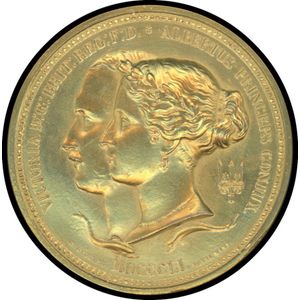1851 Crystal Palace Exhibition Medal with Queen Victoria and Prince Albert
World Exhibitions: 1851 Crystal Palace, London, gilded plaster exhibition medal obverse (80 mm) Queen Victoria and Prince Albert portraits facing left, two dolphins below, 'W. Wyon Mdcccli. Royal Mint' at base, bevelled rim, excellent condition.
You must be a subscriber, and be logged in to view price and dealer details.
Subscribe Now to view actual auction price for this item
When you subscribe, you have the option of setting the currency in which to display prices to $Au, $US, $NZ or Stg.
This item has been sold, and the description, image and price are for reference purposes only.
- Bevel / Chamfer - In furniture making, a chamfered corner refers to a technique used to create a smooth, angled edge on the corner of a piece of furniture. This is typically done by cutting away a small portion of the corner at an angle, typically 45 degrees, creating a diagonal edge, rather than a sharp 90-degree angle. This technique can be used on various parts of a piece of furniture such as table legs, drawer fronts, or door frames. Chamfering can add visual interest to a piece and can help to soften the overall look of a piece of furniture. It is often used in conjunction with other techniques, such as rounding edges or using contrasting wood species to create a more elegant, sophisticated look. Chamfering is a simple way to add a touch of elegance to a piece of furniture and it is a common technique used by furniture makers.
- Gilding - Gilding is a method of ornamentation whereby a thin sheet of gold metal is applied to items made of wood, leather, ceramics, glass and silver for decorative purposes.
For furniture including mirrors, the sheet of gold is usually applied over a coating of gesso. Gesso is a mixture of plaster of Paris and gypsum mixed with water and then applied to the carved wooden frames of mirrors and picture frames as a base for applying the gold leaf. After numerous coats of gesso have been applied, allowed to dry and then sanded a coat of "bole", a usually red coloured mixture of clay and glue is brushed on and allowed to dry, after which the gold leaf is applied. Over time parts of the gilding will rub off so the base colour can be seen. In water gilding, this was generally a blue colour, while in oil gilding, the under layer was often yellow. In Victorian times, gilders frequently used red as a pigment beneath the gold leaf.
Metal was often gilded by a process known as fire gilding. Gold mixed with mercury was applied and heated, causing the mercury to evaporate, the long-term effect of which was to kill or disable the craftsman or woman from mercury poisoning. The pursuit of beauty has claimed many victims, not the least of which were the artists who made those pieces so highly sought after today. - Obverse - Obverse means the front face of a coin or medal, and the reverse means the back face. The obverse of a coin is commonly called heads, because it often depicts the head of a monarch or famous person.
This item has been included into following indexes:
Visually similar items

Large set of antique French cast iron scales, with brass pans
Sold by
in
for
You can display prices in $Au, $US, $NZ or Stg.

Japanese ivory netsuke. Man with bamboo stick, signed. Provenance: Private Collection, ACT. Height 5 cm
Sold by
in
for
You can display prices in $Au, $US, $NZ or Stg.

Art Deco onyx & marble lady lamp 39 cm wide, 42 cm high approx. As inspected.
Sold by
in
for
You can display prices in $Au, $US, $NZ or Stg.

A mixed timber Sydney Harbour Bridge souvenir Automated cigarette box together with one other [2]
Sold by
in
for
You can display prices in $Au, $US, $NZ or Stg.
